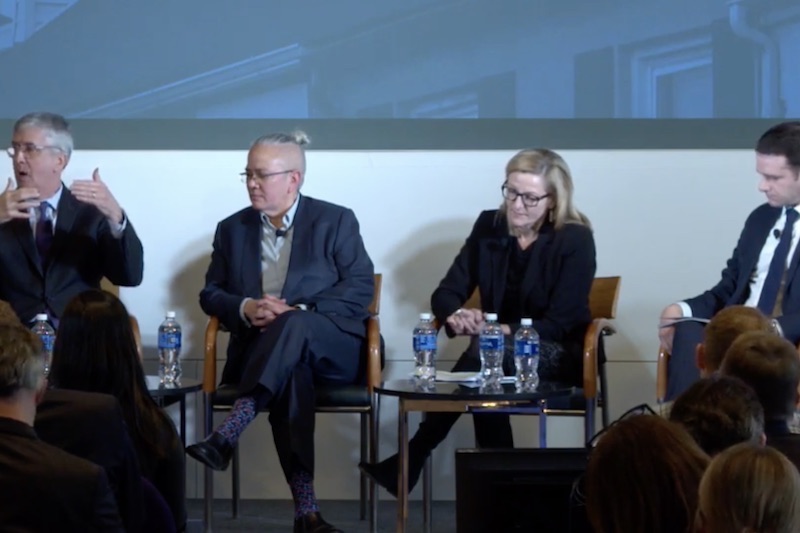Public-Private Partnerships to Address Affordable Housing Crisis

- An increase in high-income renters is reducing the affordable housing stock.
- Housing constructed today will help alleviate future housing shortages.
- The public and private sector will need to work together to address the affordable housing crisis.
Harvard University’s Joint Center for Housing Studies (JCHS) “America’s Rental Housing 2020” report found that there is a national housing shortage. At the study’s release, a panel of experts convened at the Federal Reserve Bank of Minneapolis. They discussed future steps to address the affordable housing crisis. The speakers agreed that both the public and private sectors have crucial roles for long-term solutions.
More Higher Income Renters
The report charted a steep increase from 2010 to 2018 of 10 million renter households which annually earn $75,000 or more. JCHS Managing Director Chris Herbert noted developers have been primarily building high-end apartments. The mid-level housing stock has declined. “Modest rents, apartments renting for less than $800 a month have been disappearing rapidly. They’re not disappearing in the sense that they no longer exist. But they are disappearing in the sense that their rent is now much higher,” said Herbert. He added this has resulted in renters making $30,000 to $40,000 paying higher rents.
Deidre Schmidt, the President & CEO of CommonBond Communities, commented that greater numbers of higher-income people are also starting to react to market prices. When they choose to spend less on housing, they reduce vacancies in more modestly priced apartments. She noted that this then reduces the availability of housing for lower-income renters.
These trends are occurring across the country, according to Minnesota Housing Commissioner Jennifer Leimaile Ho.
Private and Public Sector Initiatives Are Needed
The speakers agreed that private sector investors and developers, as well as government programs, are needed to scale construction.
Ho commented that public policy in the 1960s and ‘70s did not expand the housing stock. Compounding the problem, new construction slowed with the recession in 2008. Thriving cities need an influx of people to fill jobs. However, cities such as Minneapolis are still working to return to pre-2008 construction levels, Ho said.
Tony Barranco is the Senior Vice President of Real Estate Development at Ryan Companies. His company is a private market-rate and affordable housing developer. As one example of a private development involving public support, the Ford Motor Company awarded Ryan mixed-use development rights at a former assembly plant. The 22-acre complex is located in Saint Paul, MN. The Ford Site has plans for the construction of 2,400 to 4,000 housing units in the next 12 to 20 years. The development will offer different forms of housing for various income levels. It will integrate affordable housing throughout the space. Ryan has requested more than $107 million in (TIF) Tax Increment Financing. This money will pay for infrastructure and affordable housing costs. The developer is also seeking additional public funding.
Getting Construction Done in Today’s Landscape
In discussing development in general, Barranco described rising land and construction costs. Building a six-story multifamily structure in 2020 would cost 70% more than constructing the same building on the same land, six or seven years ago, he said. The development company executive said under this scenario Ryan needs to solve business challenges and drive a return.
Barranco does not see the Twin Cities housing shortage as unresolvable. But he explained the difficulty as follows: The city has a 3% vacancy rate and needs to build to reach a 5% vacancy for a healthy housing market. This would mean constructing 6,000 additional residential units that would amount to $1.5 billion in housing.
“We just need more supply. We need it from the public sector and we need it from the private sector,” he said.
Increasing Affordable Housing for the Future
Barranco opined that today’s top end construction in 30 years will age. This will increase options in the housing stock across the economic spectrum. Herbert added this means cities must now be open to development to help address future housing needs. In the event of an economic softening, facing a housing shortage would add difficulties.
Public policies could have a role in helping the situation. Some examples include zoning for density, increasing public transportation for greater use of undeveloped areas, and creating tax incentives to expand affordable housing. Barranco said there is ample capital to invest in construction. But investors expect a risk-adjusted yield on investments. “What we’re running into is additional fees and costs on the operating expense side, like property tax,” he said. “If we just fixed property taxes and could allow that investor to have a more predictable return, we could impact supply in many of the major markets.”
Public Support for Affordable Housing
Schmidt reiterated how people of greater affluence are increasingly feeling the effects of the affordable housing crisis. She predicted this growing constituency will generate more of a national conversation. She noted this will affect public policy.
Ho characterized an American optimism saying, “Government is going to have to play a role in partnership with the private sector to get this done. But I don’t think it’s a question of ‘Oh, this is hard, we can’t figure this out.’”
To find out more about real estate investments, read the Arbor Realty Trust blog. As a Fannie Mae, Freddie Mac and FHA Multifamily lender, Arbor provides financing solutions for multifamily affordable housing.

